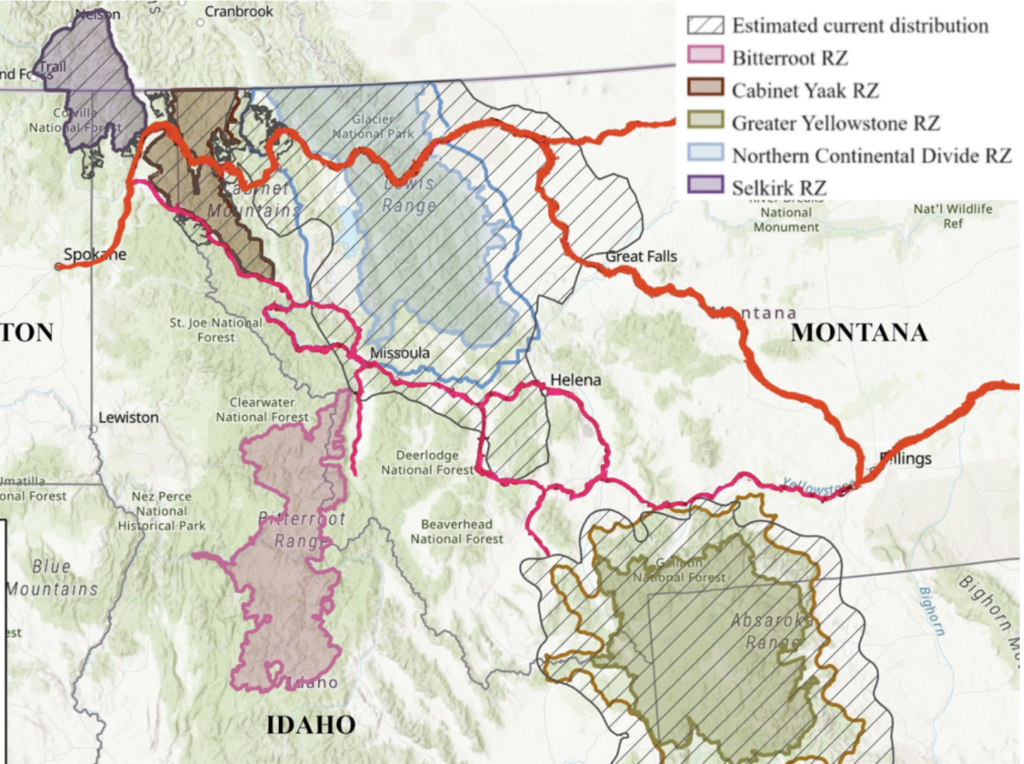Today, wildlife conservation groups sued Burlington Northern Railway Company (BNSF) for operating trains and authorizing use of its tracks by other companies that have killed many federally protected grizzly bears in or near the Northern Continental Divide and Cabinet-Yaak grizzly bear recovery zones in Montana and Idaho, respectively. Pending the completion of processes begun in 2004 to develop a habitat conservation plan (HCP) with mitigation measures and to obtain an incidental take permit, trains have continued to kill grizzly bears, including three more threatened grizzlies on the company’s tracks in 2023. The U.S. Fish and Wildlife Service has not yet issued a decision on BNSF’s request for an incidental take permit or its proposed HCP.
BNSF operates 206 miles of railway in key grizzly habitat known as the Northern Continental Divide Ecosystem (NCDE), crossing multiple national forests and along the southern border of Glacier National Park. Trains operated by BNSF or under its authority have killed or contributed to the deaths of approximately 52 grizzlies between 2008 and 2018. Trains on BNSF railways killed eight grizzly bears from the NCDE recovery zone in 2019 and three more in fall of 2023.
“We are extremely disappointed that, after all these years, BNSF has refused to change its business practices to prevent the unnecessary deaths of Montana’s iconic grizzlies, resulting in the tragic deaths of three bears just this fall,” said Sarah McMillan, Wildlife and Wildlands Program director at the Western Environmental Law Center in Missoula, Montana. “When a company chooses to operate in the epicenter of key habitat for a threatened species, it must take some responsibility to adapt practices to minimize its impacts on these animals.”
The company’s proposed, long-delayed HCP fails to include any measures to change train operating schedules or speeds, which could prevent the deaths of threatened grizzlies from trains, and would allow BNSF to continue its operations as usual.
“The Burlington Northern railway runs right alongside Glacier National Park, some of the most prime grizzly habitat in the world, so the railway should be expected to slow down and take precautions to ensure grizzly bears aren’t put at risk from train operations,” said Erik Molvar of Western Watersheds Project. “With the addition of Montana Rail Link, BNSF now has additional responsibilities to protect grizzly bears in the Cabinet-Yaak ecosystem.”
“Burlington Northern Railway has been given carte blanche to run trains through core grizzly bear habitat for far too long,” said Lizzy Pennock, carnivore coexistence attorney at WildEarth Guardians. “Enough is enough. BNSF must be held responsible for the dozens of federally protected bears it has already killed, and for the dozens more it will predictably kill if the company refuses to change.”
“It is truly ludicrous for BNSF to kill at least 63 threatened grizzly bears with no tangible action from the U.S. Fish and Wildlife Service, the agency in charge of protecting endangered and threatened species,” said McMillan. “The draft incidental take permit allowing BNSF to kill even more bears annually than it has on average to date is appalling.”
Contacts:
Sarah McMillan, Western Environmental Law Center, 406-549-3895, gro.w1752287265alnre1752287265tsew@1752287265nalli1752287265mcm1752287265
Pete Frost, Western Environmental Law Center, 541-543-0018, gro.w1752287265alnre1752287265tsew@1752287265tsorf1752287265
Erik Molvar, Western Watersheds Project, 307-399-7910, gro.1752287265sdehs1752287265retaw1752287265nrets1752287265ew@ra1752287265vlome1752287265
Lizzy Pennock, WildEarth Guardians, 406-830-8924, gro.s1752287265naidr1752287265aught1752287265raedl1752287265iw@kc1752287265onnep1752287265l1752287265

Thick red line in north shows BNSF railways; thinner red line in south is Montana Rail Link railways

